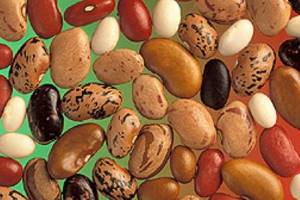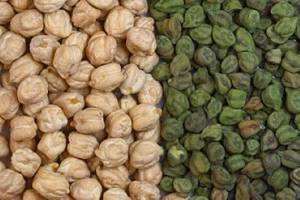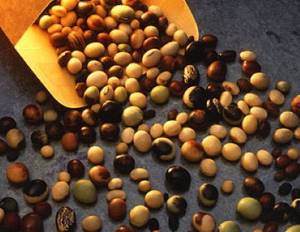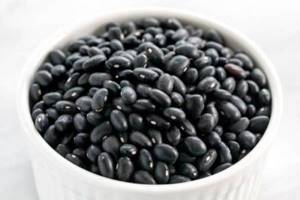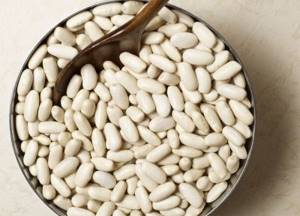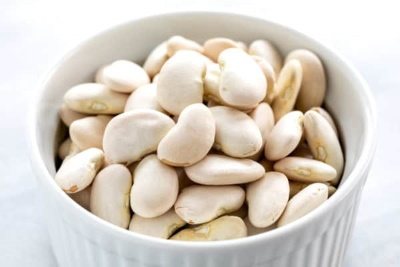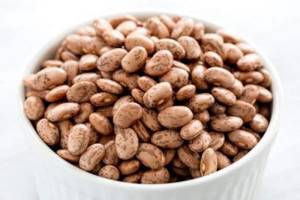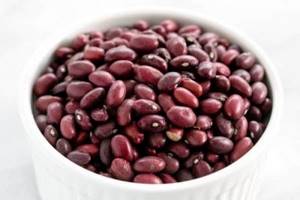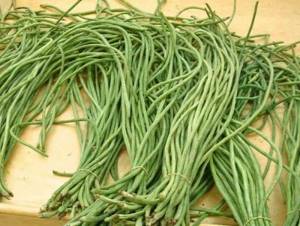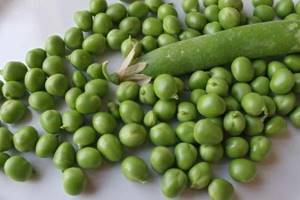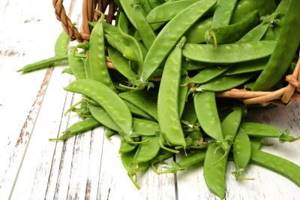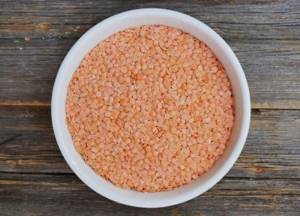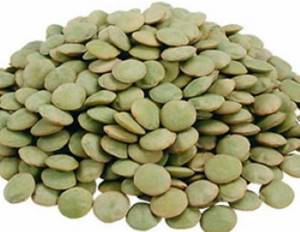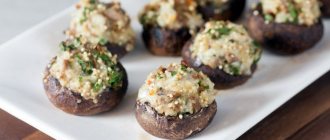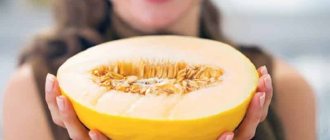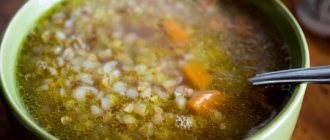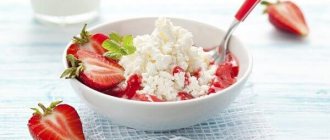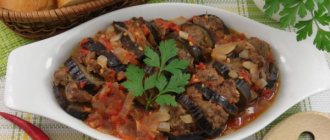Calorie content and chemical composition, BJU
There are more than 30 types of legume products in nature, and each of them has a unique elemental content.
Due to their rich protein content, beans are often used as meat substitutes.
They consist of vegetable proteins (40%), carbohydrates (50-55%), and are rich in vitamins A, B, B, C, as well as phosphorus, iron and magnesium.
Energy value and BJU of the most popular types:
| Kinds | Squirrels | Fats | Carbohydrates | Calorie content in kcal per 100 g. |
| Green beans | 6,1 | 0,2 | 10 | 62 |
| Green beans | 3,2 | 0,3 | 13,7 | 30 |
| Soybeans | 34, 8 | 17,1 | 26,3 | 331 |
| Green peas | 5,2 | 0,2 | 13,6 | 71 |
| Beans | 22 | 2,1 | 55 | 292 |
| Dry peas | 20,1 | 2,1 | 54,3 | 298 |
| Peas | 23 | 1,5 | 56,7 | 323 |
| Lentils | 24 | 1 | 54,7 | 283 |
The role of proteins
The value of beans of any type lies in their high content of proteins and amino acids.
Protein is a valuable enzyme for building and strengthening muscle mass, immunity, and growth.
Note! Due to their rich protein content, beans often act as meat substitutes.
To maintain balance, it is necessary to consume foods with both animal and plant protein in equal proportions.
The role of vitamins and minerals
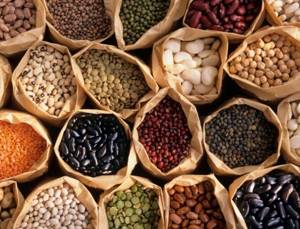
Any type of beans contains vitamins of groups A, B1, B2, C, as well as a rare vitamin PP (nicotinic acid), which are actively involved in the development and maintaining the vital functions of the body.
Also, eating beans allows you to compensate for the lack of iron, phosphorus, magnesium, carotene, potassium, calcium and sulfur, which makes them an integral part of the diet.
Molybdenum, which is part of the composition, is involved in the fermentation process and neutralizes harmful preservatives, normalizes sugar levels.
BJU ratio
Do you know how much protein is in red beans and other types of this product?
| 100 g of raw beans | White | Red | Capsicum |
| Calorie content | 325 | 310 | 25 |
| Proteins , g | 20,9 | 21 | 2 |
| Fats, g | 1,8 | 1,6 | 0,2 |
| Carbohydrates, g | 64 | 52,7 | 3,6 |
Note. The numbers may fluctuate. They are influenced by the variety and location of the bean.
Conclusion: the protein content in red and white representatives of the legume family is high. This protein is easily digestible. But there are also a lot of carbohydrates.
Attention! Unlike meat, beans have virtually no fat (no more than 2%).
Benefits for the body
When they enter the body, the beneficial substances in beans perform the following important functions:
- participation in the breakdown of fats;
- acceleration of metabolism;
- normalization of glucose levels;
- cleansing the intestines of toxins and free radicals;
- neutralization of harmful preservatives.
Be sure to read: How many calories are in canned green peas, the benefits and harms of the product in a can, BJU
Thus, adding a bean side dish to your diet allows you to saturate the body with all vital microelements.
Oncological diseases
Legume seeds have a unique property - slowing down the growth of tumors. Seeds in pods have this ability; adzuki beans are especially effective against cancer.
Note! The content of microelements in beans decreases during heat treatment. To preserve the vitamin composition, it is recommended to avoid prolonged frying and use of a pressure cooker.
The presence of legumes in the diet reduces the risk of developing cancer of the digestive tract, kidneys, ovaries, and bladder.
Benefits for the gastrointestinal tract
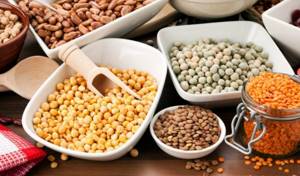
Thanks to molybdenum, beans help break down the preservatives added to most other foods.
They also have an anti-inflammatory and astringent effect, due to which they fight inflammation of the kidneys, liver and gastrointestinal problems.
Doctors recommend using beans to obtain a natural diuretic and laxative effect for diarrhea.
Benefits for the blood and heart
A special feature of legume products is their effect on reducing glucose and purifying the blood . Regular consumption of beans is recommended for diabetics as they help lower cholesterol.
Folic acid and potassium stimulate an increase in natural defenses and also have a beneficial effect on the functioning of the cardiovascular system.
By including beans in your menu, you can strengthen your heart muscle and prevent the development of cardiac diseases.
Dietary product
Due to their high content of valuable minerals and low calorie content, beans are considered one of the healthiest dietary foods.
They help quickly satisfy hunger and ensure a feeling of fullness for a long time, and the fiber they contain speeds up metabolism, cleanses the body and allows you to break down fats faster.
Therefore, this category of products is recommended for consumption by people trying to lose excess weight.
The benefits of sprouted fruits
The main advantage of eating sprouted bean seeds is that in this form the beans contain twice as many vitamins and minerals.
When green peas and beans are sprouted, the amount of vitamins B and E increases several times, and vitamin C and phosphorus are added.
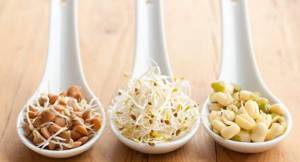
The main advantage of eating sprouted bean seeds is that in this form the beans contain twice as many vitamins and minerals
Regular consumption of sprouted grains of legumes in the diet can effectively cleanse and rejuvenate the body , stimulate the production of hemoglobin, lower blood pressure and improve the body's immune defense.
Recommendations for using beans
First of all, beans are a tasty, healthy, dietary ingredient that is used as a complete separate product or as a raw material for preparing various dishes. Soups, appetizers, salads, vegetable stews and even desserts are prepared using beans. It is considered an excellent filling for pies or pancakes.

Any dish made from this ingredient is highly filling, so it is not recommended to eat heavy foods with boiled beans.
Beans are successfully used in folk medicine and cosmetology. They are used to make nourishing and rejuvenating masks, creams, and lotions for the skin of the face and body. Decoctions and tinctures from the pods and fruits of the crop are used to treat many ailments: tuberculosis, diabetes, hypertension, rheumatism, diseases of the genitourinary system.
Beans, due to their wide range of uses and availability, are in demand in many countries around the world. In addition to the fact that it tastes great and allows you to quickly satisfy the feeling of hunger, it is extremely healthy, containing a wide range of active biological substances that allow you to normalize the functioning of many body systems and improve its general condition.
Contraindications
Frequent consumption of beans is not recommended for people with sensitive intestines and stomach diseases, as this can lead to microflora irritation, gas formation and bloating.
The purine substances they contain aggravate the symptoms of nephritis and gout, so eating beans is strictly prohibited for these diseases.
Other contraindications to eating beans include: flatulence, constipation, diseases of the gallbladder, pancreas. Elderly people and children should also consume beans with caution.
Be sure to read: Calorie content of pea puree per 100 grams: what determines how many calories are in peas with butter
A little about red beans
This is a legume, an annual plant. It has a curly stem, beautiful flowers, dense, large fruits of bright red color. This is an unpretentious plant that can be easily grown in your summer cottage. Red beans have the thickest skin, and the flesh is slightly oily, soft, and has a pleasant nutty flavor.
This plant is native to India and Central America. Once upon a time, Indian tribes consumed it along with pumpkin and maize, considering it the basis of their diet. Today, preparing Mexican dishes is almost impossible without beans. It is used to make salads, boiled and consumed as a side dish.

Cooking recipes
Among the most popular cooking methods are: steaming, casseroles, soups, vegetable salads, stewing in oil, stews and others.
In addition, flour is prepared from legumes, which is added when baking baked goods to increase their benefits and nutritional value.
Beans for weight loss
Beans are a nutritious, low-calorie food that is ideal for weight loss.
Beans contain a minimum of vegetable fat and carbohydrates, but a lot of fiber, which has a beneficial effect on the body of a person losing weight.
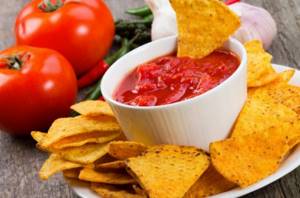
Vegetarian salsa
Adding different types of legume products from the list to your food will allow you to quickly satisfy your hunger, a feeling of comfort and satiety for a long time, which significantly reduces the amount of food consumed.
Beans speed up metabolism, which allows you to digest food and break down fats faster.
List of legume products:
- beans;
- peas;
- chickpeas;
- lentils;
- peanut;
- soy;
- lupine;
- tamarind.
Vegetarian salsa
A popular dietary and vegetarian dish with beans is vegetarian salsa - a cold Mexican soup made from several types of beans, cilantro, corn, red peppers, onions and tomatoes with spices.
Ingredients:
- corn grains – 1 cup;
- red sweet pepper – 1 pc.;
- canned beans – 100 g;
- green peas – 80 g;
- onion – 1 pc.;
- green onion – 2 pods;
- green pepper – 1 pc.;
- tomato – 4 pcs.;
- tomato juice – half a glass;
- cilantro – 15 g;
- chili powder – 10 g.
The traditional recipe involves the following preparation steps:
- Pour boiled water over the tomatoes, peel them and chop them.
- Chop a few green onions and cilantro.
- Place the pan on the fire, add olive oil and all ingredients.
- Fry vegetables in oil, sprinkle hot pepper powder on top, add water and cook for 5-10 minutes.
- Remove the pan from the heat, add beans, green peas, and add tomato juice.
- Transfer contents to a tureen and serve cold.
Refried beans
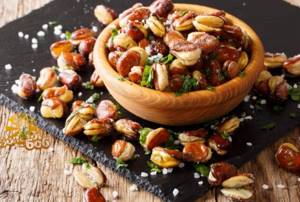
Fried beans are considered a delicious dish and a dietary food category. You can prepare this dish using various legume products from the list, but beans are the best.
The following ingredients will be required:
- dried beans – 150 g;
- soda – 1 tsp;
- sunflower oil – 2 tbsp. l.;
- sea salt – 1 tsp.
Preparation includes the following steps:
- The beans must be soaked in cold water for 16 hours, add 1 tsp. soda
- Remove the beans from the water, dry them, and cut them on the sides.
- Heat a frying pan with vegetable oil, add the fruits, fry until golden brown.
- Sprinkle with sea salt and place on a plate.
- Serve with fresh herbs.
Be sure to read: Calorie content of pea puree per 100 grams: what determines how many calories are in peas with butter
Lentil sweets
In addition to traditional dietary dishes, you can also prepare unusual treats – sweets – from beans.
To prepare low-calorie and healthy sweets, any type from the list of legume products is used, but most often lentils, nuts and dried fruits are used as the basis.
For cooking you will need:
- red lentils – 140 g;
- dates – 10 pcs.;
- dried apricots – 80 g;
- raisins – 50 g;
- chopped walnuts – 110 g;
- cocoa powder – 4 tbsp. l.;
- sugar powder – 40 g.
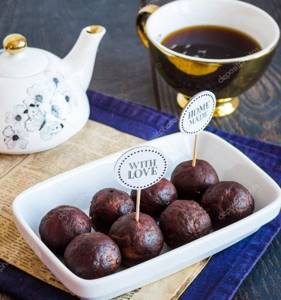
Recipe for making delicious dietary lentil candies:
- Boil a glass of red lentils and let cool.
- Take 100 g of dried apricots, 10 dates, 50 g of raisins and walnuts, add everything to a blender and grind.
- Add lentils to the blender and grind again.
- Add 1 tbsp to the resulting mixture. l. cocoa and powdered sugar and mix.
- Place in the refrigerator for a couple of hours.
- Form balls of equal size and roll in powdered sugar.
Carbohydrate or protein
Beans contain both complex carbohydrates and proteins . This composition makes it an indispensable product for a variety of diets. But green beans stand out on this list with their proteins, fats and carbohydrates, close to the values of vegetables. There are few carbohydrates and proteins in it. The main value is fiber. The dietary fiber of this type of legume improves digestion.

What plants are legumes?
In addition to traditional beans and peas, the list of legumes includes many more plants with special properties for the human and animal body.
Legume fruits differ in value and energy composition, size, color and method of germination.
Among the most common plants in the list of legume products, it is worth highlighting:
- sweet clover;
- Vika;
- chickpeas;
- feed peas and beans;
- lupine;
- sainfoin;
- Red clover;
- peanut.
This category includes both food and ornamental plants, trees and shrubs, which have been used for many years for feeding livestock, eating and for decorative purposes.
Advantages and benefits of legumes
Why and how are they so good? Beans and legumes are not only rich in protein, which a person needs every day (and can be obtained not only from meat), but also in plant fiber, B vitamins, iron, folic acid, calcium, potassium, phosphorus, zinc. Most legumes are also low in fat. Beans are nutritionally similar to meat, but with lower iron levels and no cholesterol. This makes them an excellent choice for vegans and vegetarians, as well as people who temporarily refuse animal foods - for example, during fasting, or to cleanse the body for the sake of health, according to medical prescriptions.
Features of use for the female body
- The product is especially useful for women, as it brings the following benefits to the body:
- helps normalize the menstrual cycle and maintain physical and psycho-emotional state during this period;
- saturates the body with iron, which is important during pregnancy;
- is a preventative against breast cancer.
Important! When breastfeeding, you must approach the use of beans with caution. It needs to be introduced into the diet gradually, paying attention to the reaction of the body of both the child and the mother.
Vegetable legumes
Legume products, which are difficult to list in full, are very diverse. Typically these include seeds of plants of this genus, consumed fresh or cooked. Beans, chickpeas, lentils, peas and soybeans are the most common varieties. However, other parts of leguminous plants can also be eaten.
For example, green beans and peas are widely known and are harvested at a certain stage of ripening. Legumes are nutritious, versatile and healthy. Therefore, it is important to know their basic properties and features.
| Name of culture photo | Appearance | Benefits and consumption rates | Harm | Calorie content, BJU per 100 g |
| Beans
| A small bush-type plant. Cylindrical bean pods have a hard shell with constrictions and contain 4-10 grains, which are oval in shape. Each grain is covered with a skin, the color of which can be white, green, burgundy, brown, black, or a combination of these colors. It has a slightly oily consistency and a neutral or sweetish taste. | Reduces cholesterol levels, regulates blood glucose levels in diabetics. Reduces the risk of many types of cancer. regulates the functions of the colon. Helps prevent and treat constipation and other intestinal problems. | Eating raw grains can cause phytohemagglutinin toxin poisoning. Heat treatment removes this substance from the product and makes it safe. | 337 kcal, 22.33 g/ 1.5 g/ 60.75 g |
| Peas
| A fast-growing annual herbaceous plant that requires trellis or stakes to support its growth. Green pods with short stems reach a length of 5-8 cm, and can be cylindrical, flat or slightly curved. Each pod contains 2-10 smooth green grains. | It is the lowest calorie legume, so it is great for weight loss. A large number of vitamins and antioxidants in its composition help the body develop resistance to infectious diseases and remove harmful anti-inflammatory free radicals from the body. Helps reduce cholesterol levels in the body. Stimulates the activity of osteoblasts within bone cells, which plays an important role in the treatment of Alzheimer's disease by limiting damage to neurons in the brain. Prevents the development of lung and oral cancer. | Some varieties contain trace amounts of oxalic acid, which can crystallize in the body as oxalate stones in the urinary tract. To avoid this, it is recommended to drink more water. | 81 kcal 45.2 g/ 0.40 g/ 14.45 g |
| Lentils
| An annual low-growing small shrub. The short, flat and oblong pods contain 1-2 flattened grains that can vary in size, color, texture and flavor depending on the variety. Yellow, green and red lentils are smaller and softer, dark green ones are larger and harder. | It is low in fat and cholesterol, which is good for the heart and vascular system. Unlike other large legumes, lentils contain relatively less dietary fiber, which makes them easier to digest and good for people suffering from flatulence and inflammatory bowel disease. Isoflavones in its composition reduce the risk of cancer and osteoporosis, especially in postmenopause. Rich in many vitamins that act as cofactors for enzymes of carbohydrate, protein and fat metabolism. High iron content improves memory, cognitive abilities, and helps prevent anemia. Improves cellular metabolism and blood cell production due to copper content. They are a good source of potassium, an electrolyte that protects the heart and blood vessels. | Lentil allergy is quite rare. | 352 kcal, 24.63 g/ 1.06 g/ 63.35 g |
| Chickpeas
| Dicotyledonous dense shrub with small feathery leaves. Unlike peas and beans, chickpea pods are short and convex, containing 1-3 grains, the color of which can be reddish, green, brown, black and cream. The texture may be pasty or dense, depending on the variety. | A large number of vitamins and microelements help strengthen the immune system and improve bone health. Contains high levels of dietary fiber, which helps protect the colon lining by reducing the time it is exposed to toxic substances, and also removes cancer-causing chemicals. Reduces cholesterol levels in the blood by binding bile acids in the colon. Regulates carbohydrate, protein and fat metabolism in the body. Contains a lot of potassium, necessary for the normal functioning of the heart and circulatory system. | Chickpeas rarely cause food allergies, but frequent consumption can cause stomach discomfort and increased gas production. The product contains methionine, an amino acid that interferes with the absorption of nutrients. Eating wheat or rice with chickpeas will neutralize this effect. | 376 kcal, 20.47 g/ 6.04 g/ 62.95 g |
| Soybeans
| An annual dicotyledonous herbaceous plant. The young green pods are about 3-5 cm long and may be convex, flat or slightly curved. Each pod contains 2-5 round, light green, smooth grains that become firm and dense when ripe. | It is a powerful source of protein (on par with meat), rich in all essential amino acids. The fats in its composition are 78% unsaturated, do not contain cholesterol and contain lecithin. This provides liver health benefits. Contains significant amounts of dietary fiber, vitamins, minerals and plant sterols, which improve digestion, help reduce blood cholesterol and prevent the development of cancer and osteoporosis. It contains a large amount of the phytoestrogen formononetin, which promotes angiogenesis (regeneration of new blood vessels). | Soy grains and soy products are among the most common allergenic foods. Symptoms of soy allergy are a kind of hypersensitivity reaction in some people to certain substances in its composition. Fresh soybeans contain anti-nutrients that make it difficult to absorb nutrients. They are neutralized by cooking and fermentation. | 446 kcal, 36.49 g/ 19.94 g/ 30.16 g |
| Peanut
| A small annual dicotyledonous plant growing up to 30 cm above the ground. Its yellow flowers, after self-pollination, develop into "ovaries" called pedicels, which quickly elongate and descend deep underground, where they develop into hard pods. Each plant can contain from 10 to 150 pods, which have a hard, wrinkled outer shell with 2-3 constrictions. The oval-shaped grains are covered with a thin brown husk, have a harsh texture and an earthy taste, sometimes with a sweetish tint. | Contains a variety of health-promoting nutrients, minerals, antioxidants and vitamins essential for optimal health. Its monounsaturated fatty acids help prevent coronary artery disease and stroke risk by promoting healthy lipid metabolism. It is a source of dietary protein containing amino acids of excellent quality necessary for the growth and development of the body. Contains high concentrations of polyphenolic antioxidants, primarily P-coumaric acid. This compound reduces the risk of stomach cancer by limiting the formation of carcinogenic nitrosamines. Resveratrol in its composition has a protective function, helping against cancer, heart disease, degenerative nerve diseases, Alzheimer's disease and viral and fungal infections. This compound may also reduce the risk of stroke by changing molecular mechanisms in blood vessels, increasing the production of vasodilator hormones. Contains a fat-soluble antioxidant that helps maintain the integrity of mucous membranes and skin by protecting against harmful free radicals. 100 g of peanuts provides about 85% of the daily value of niacin, which promotes healthy blood flow to the brain. | Peanut allergy is a type of hypersensitivity reaction to nutrients in peanuts. Peanuts are one of the crops that are easily susceptible to fungal (mold) infection, especially the aflatoxin-producing Aspergillus flavus. It is a potent and dangerous known carcinogen that can cause cirrhosis and liver cancer. Roasting helps reduce toxin levels in the beans. | 567 kcal, 25.80 g/ 49.24 g/ 16.13 g |
Legumes, of which there is quite a list, come in different shapes, sizes and colors and can be eaten in many forms - fresh, dried, canned or ground into flour. Some of them have a lot of varieties and varieties.
Beans
Beans have edible pods with grains inside.
She is the source:
- niacin;
- thiamine;
- riboflavin;
- vitamin B6 and many other nutrients.
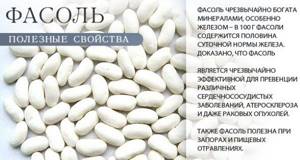
It is also rich in complex carbohydrates and fiber. All these compounds are necessary for normal growth and construction of body tissues. Recent research has revealed that beans contain "anti-aging" agents or antioxidants in the seed coat, namely 8 powerful flavonoids. This product is an ideal nutritional supplement for people interested in losing weight.
At the same time, beans help lower cholesterol, improve digestion and even prevent intestinal cancer.
Beans are consumed raw, sprouted or cooked. Dried grains can be ground into flour, from which a vegetable analogue of milk and clear noodles are prepared, and also used to prepare other dishes. Dried beans need to be soaked before cooking because they are very tough. Fresh grains can be cooked without prior preparation.
Beans are a popular food around the world, from Egypt and Italy to Mexico and Brazil. Today, many varieties of this crop have been developed with different tastes and textures.
| Species name and photo | Description |
| Azuki
| A round red bean that is traditionally used in Asian sweets. Its paste is usually added to baked goods and cakes. |
| Black beans
| A plant with large, oval-shaped grains popular in Mexican and Brazilian dishes. |
| Borlotti (or cranberry beans)
| It has cream-colored grains with red spots that turn light brown when cooked. This variety has a creamy texture and nutty flavor. Borlotti is popular in Italian dishes and can be used in soups and stews, as well as cold salads. |
| Cannellini
| A white bean that has a mild, nutty flavor and creamy texture and is popular in Italian dishes. The grains hold their shape well and are often used in salads and stews. |
| Fava
| It has grains of greenish-cream color, oval and flat shape. This variety was developed in the Middle East and is now widely used in cooking throughout the world. |
| Lima
| They are also called butter beans because their white, flat grains have a buttery texture. They are great for soups, salads, purees or sauces, and casseroles. |
| Mung
| It is distinguished by grains that are ovoid in shape and green in color when ripe. This bean is native to the Indo-Burma region and is used as a base for both savory and sweet dishes. Mung bean flour can be used to make bread and pasta. |
| Pinto
| The beans are cream colored with brown specks. They are most often used for frying. |
| Red beans
| It has a dark burgundy color. The grains hold their shape well when cooked, so they can be added to almost any dish. |
| Black Eyed Peas
| It grows in the form of long light green pods with small dark brown grains. The pods are edible and are eaten after boiling or steaming. |
| Green bean
| Also called capsicum, it is characterized by narrow, medium-length pods containing small green grains. It is consumed unpeeled (however, the hard ends are usually cut off). These beans can be steamed, boiled or fried in oil. |
Peas
Field peas are one of the first crops domesticated by humans. Today it is actively grown both on an industrial scale and for personal use. Its grains are high in protein and are also a good source of vitamins A and K and thiamine. The most commonly consumed grains are hulled grains, but some varieties can be eaten with the pods. These varieties are popular in Asian countries. Soups, salads and stews are prepared from the pods cut into pieces.
Fresh or frozen green (unripe) peas are eaten in their natural form and added to many dishes. In addition, this product is known in canned form.
Ripe grains are dried to increase shelf life. Often, whole dried peas are made into split peas - the kernels are split to remove the hard outer layer and then split into two halves, which are the natural parts of the cotyledon. This reduces the time required to prepare it. Whole dry peas need to be pre-soaked, but split peas do not.
The following varieties of this product are grown around the world:
| Species name and photo | Description |
| Shelling, soup or English peas
| It is distinguished by rough and hard pods and large grains. It is used only in purified form. The harvest can only be harvested when the pods become plump and begin to acquire a waxy sheen. There are a number of varieties of these peas that are left on the vine until completely dry. |
| snow peas
| It is distinguished by soft, flat-shaped pods and very small grains. It is eaten unpeeled, most often in unripe form. The pods are small in size and have very soft walls, without hard fibers. |
| Sugar snap peas
| It has edible pods and can be harvested when the pod is just beginning to swell. However, they are not as soft as snow peas. The grains are soft and have a distinct sweet taste. |
| Purple or purple peas
| It got its name from the color of the pods. Its grains are dark green and quite large, with a neutral taste. |
Lentils
Lentils are one of the oldest known food crops. Unlike other legumes, it does not need to be soaked before cooking. Lentils are usually sold separated into natural seed halves, which reduces cooking time. Dry grains are used to make flour used for various culinary recipes. Unripe lentil pods and sprouted seeds can be eaten in their pure form.
The following types of lentils are currently known:
| Species name and photo | Description |
| Yellow and red lentils
| It has small and +++ round grains. It is commonly used in soups and Indian curries. |
| Green lentils
| Larger than other species, and has flattened grains. It is quite tough, so it is prepared by boiling or stewing for a long time. |
| French lentils
| It is distinguished by dark green grains. They have a nutty flavor and hold their shape well when cooked, making them great for salads or side dishes. |
Chickpeas
All chickpea varieties come from the species Cicer arietinum. Currently, two varieties of this crop are grown - light brown Kabuli and Desi chickpeas, which come in different colors (brown, yellow, orange, black and green). This product is best known as the main ingredient in hummus and falafel. However, chickpeas can be used in other ways, including in soups, salads, stews and curries. The product is also popular fried.
This is an easy and nutritious snack that contains fewer calories than nuts, which may help you lose weight. Boiling is the main method of cooking chickpeas. This may take some time, especially if you are using dried grains. Pre-soaking reduces cooking time. Desi chickpeas are a common ingredient in Indian dishes.

Traditionally, it is used in its whole form and also ground into flour (besan), which is used in various ethnic dishes (Indian snacks, onion bhajis or vegetable pakoras, pancakes and flatbreads).
Kabuli chickpeas are eaten whole. It is often used to prepare many dishes in the Middle East and Mediterranean regions.
Soybeans
The soybean was first recorded as a domesticated plant around the 11th century BC in Northeast China. By the first century AD, this culture could be found in most of China, as well as in neighboring countries. Over the next 14 centuries, the soybean slowly spread throughout the rest of Asia, becoming the mainstay of the region's diet. In Europe they did not know about it until the 19th century.
Soybeans are the most economically important legume product in the world. They are distinguished by the highest protein content and have a unique amino acid balance. Soybeans also contain a lot of iron, calcium, phosphorus, magnesium and B vitamins. Soybeans are the best source of lecithin, which lowers blood cholesterol levels.
This is a great source:
- essential oil;
- linolenic acid;
- vitamin E.
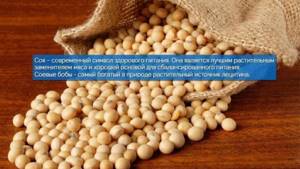
Due to their relatively high fat content, grains must be protected from oxygen for long-term storage. Soybeans do not have a very pleasant taste, so they are rarely eaten in their natural form. They are usually used to make various products such as soy milk, tofu, tempeh, miso, soy sauce, and natto.
In addition, its sprouts, which are very rich in vitamins and enzymes, are eaten all over the world. Green soybean pods are used in Asian cooking and are known as edamame.
Peanut
Legume products, the list of which is voluminous, include peanuts, which many consider a nut. In fact, this crop belongs to the Fabaceae family of plants and grows underground, and has no relation to true nuts. Peanuts (Arachis hypogaea) or "groundnuts" grow underground, making them more closely related to plants such as peas and lentils. Its nutritional composition is more reminiscent of nuts than legumes.
Peanuts contain a range of essential nutrients, including protein, dietary fiber, vitamins and minerals. The grains contain 25% protein, which is significantly higher than that found in animal foods such as eggs, dairy products and many types of meat and fish. Peanuts are also high in fiber, low on the glycemic index, contain no cholesterol, and are low in saturated fat and sodium.
The product is the source of:
- B vitamins;
- thiamine;
- niacin;
- pantothenic acid.

Regular consumption of peanuts has been shown to be associated with a reduced risk of coronary heart disease, hypertension, obesity, cancer and inflammation. Despite its calorie content, it does not lead to rapid weight gain and obesity. Additionally, eating peanuts may improve insulin sensitivity in adults.
The presence of nutrients in white beans
White beans, like red beans, are a source of protein, fiber, vitamins C and group B. They also contain iodine, boron, iron, silicon, potassium, manganese, vanadium, chromium, selenium, and sulfur.
Among all vegetable crops, white beans are distinguished by their high amino acid content. For example, by eating only one hundred grams of product a day, you replenish the body’s daily need for amino acids from 20 to 40 percent. Beans contain about 61 percent purine bases. The white variety is a feminine product in the same way as dill, because it contains many plant hormones - phytosterols.
The story of one experiment
Recently, one TV channel conducted an interesting experiment. Three overweight women of approximately the same age lost weight over 10 days using beans. They had the same diet, but they used different types of beans. At the end of the study, the results were compared.
What type of legume product do you think the contender managed to lose the most weight with? The best result was achieved by the participant who used green beans in her dishes. The organizers of the experiment explained this by the fact that the green variety is the lowest calorie of all types of this legume product. Second place went to the participant with red beans. Third, she used the white variety in dishes.
But it's not about the places. All participants lost noticeable weight in 10 days. With an individual nutrition program, each of them lost from four to six kilograms of weight during the experiment.
Red beans on the weight loss menu
The presence of beans in the menu of vegetarians, fasting people and people who simply decided to tidy up their body a little by losing a couple of unnecessary pounds is completely justified. Beans are a dietary product, but at the same time they are very filling, and after eating them, the feeling of hunger will not bother you for a long time. Many diets include beans in the diet, these are hypolipidemic, for a flat tummy and legume diet. If you replace dinner with boiled beans at least a couple of times a week, then over time it is possible not only to lose excess weight, but also to improve the condition of your skin and hair.
Read also: How to remodel an old house
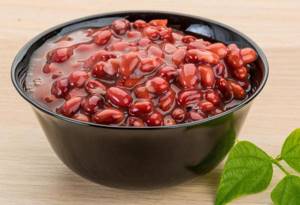
White beans
This variety is native to Peru. From there the culture spread to South and Central America. In the fifteenth century, travelers from Spain tasted white beans in the New World and decided to bring the product to Europe. This legume is famous for its nutritional value and is necessary for constant consumption by people who reject food of animal origin, that is, vegetarians. Everyone knows that dairy products and meat dishes contain substances necessary for the normal functioning of the body. Who said white beans don't have them? But more on this later, when considering its composition. First, let's decide on the main question: are white beans a protein or a carbohydrate?
